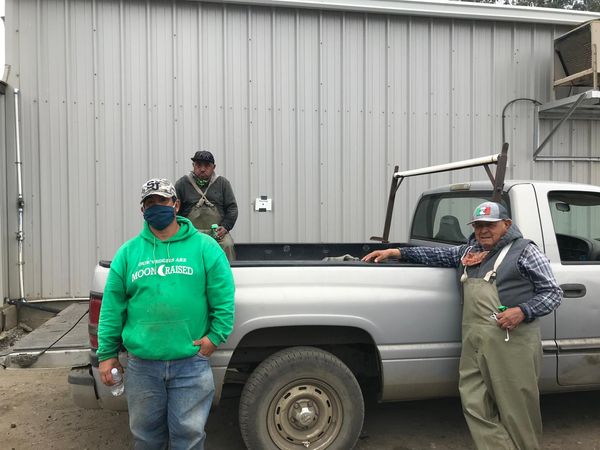
Dexter Melchor Matías works in the Zapotec Indigenous town of Ixtlán de Juárez, about 1,600ft (490 metres) above the wide Oaxaca valley in Mexico, where community forestry has become a way of life. Like him, about 10 million people across the country live in and make a living from forests, with half of that population identifying as Indigenous.
As average temperatures soar around the world and wildfires rage across the Americas, in Mexico, where more than a quarter of the country suffers from drought, the number of wildfires has remained steady since 2012.
More than half of Mexico’s forests are in community and Indigenous hands, a situation unlike anywhere else in the world, which, according to experts, helps explain why the country has done better at controlling large fires.
“There are more wildfires south of here because they have a lot of small private properties,” says Melchor Matías, a community forest manager. “They just don’t have the capacity to monitor their forests as we can.”
Worldwide, an estimated 36% of remaining intact forest landscapes are on Indigenous land. Studies show that not only do community-controlled forests absorb more C02 than those under government or private control, but deforestation rates are lower. They also suffer less during severe water shortages, greatly reducing wildfire risk.
Ixtlán’s long, narrow territory of 19,000 hectares (47,000 acres) encompasses snowy mountain peaks and lush lowland jungles with cloud forests in between. Rather than clearcutting, vertical ribbons of pine and oak between six and eight hectares (15 and 20 acres) are logged in strips down mountainsides, enabling the forest to regenerate naturally.
Logging operations are closely regulated by Ixtlán’s community forestry enterprise, which wrested forests away from a private concession in 1982. Ixtlán’s success had been happening all over Mexico since, after 1970, communities took advantage of state forestry reforms and subsidies to exert greater local control.
Of the more than 21,000 communities with forest ownership in Mexico, about 1,600 engage in sustainable logging, mostly in the southern part of the country.
For forest enterprises such as the one in Ixtlán, maximising profits has never been the principal goal. “Our interest is in creating jobs,” says the conservation scientist Guadalupe Pacheco-Aquino. In the second-poorest state in Mexico, relatively well-paid rural jobs like those community forestry creates in Ixtlán are a rarity. “Forestry has been instrumental in helping people to get out of poverty.”
Investment in public works such as roads and schools and generating local income through profit-sharing round out the community forestry enterprises mandate. “These businesses engage with the market but are not market-driven,” says David Bray, professor emeritus of earth and environment at Florida International University. “They are successful because of favourable state policies, high and stable prices for wood products and their sophisticated levels of community governance.”
A mostly male community assembly directs Ixtlán’s logging and a sawmill and furniture factory. Being a voting comunero, as assembly members are known, brings considerable obligations and status. It is an inherited position, generally passed from father to son. “That is beginning to change,” says Pacheco-Aquino, “as more fathers are leaving the position to their daughters”.
Decision-making is grounded in Indigenous customs that put the group’s interests above the individual, value elders’ knowledge, and prioritise consensus. Political parties are excluded. Instead, technically skilled senior members represent all the local families and participate in every significant decision.
“From a business point of view, even though we now have a consulting committee to accelerate decision-making, this system takes a lot more time. That is the disadvantage,” says Pacheco-Aquino. “But our structure has the advantage that everyone who has an interest in the outcome has a voice.”
Melchor Matías says: “With so many bosses, it was difficult to adjust at first. But gradually, you get used to how it works, and its benefits for the community outweigh the amount of time involved.”
Noemí Cruz Hernández is the manager of the community’s furniture factory. The forestry engineer supervises 40 employees who make tables, benches and chairs from the high-quality pine grown in Ixtlán’s tropical montane forests. The operation is certified by the Forest Stewardship Council.
“We mostly sell school furniture to the state government, but we’re working on becoming more independent. We just opened our second retail store in Oaxaca city,” she says. Using forest revenues to diversify its economy, Ixtlán now has a community-run petrol station, food store, water bottling facility, credit union, and an ecotourism inn, generating the sustainable economic development Mexican communities need.
In Ixtlán, workers are paid minimum wage, plus benefits, for 48 hours a week. “Our biggest problem is turnover,” Cruz Hernández says. “We train people, and then they leave for better opportunities elsewhere.”
People leaving the area is an issue in Ixtlán, even after establishing a local university – Universidad de la Sierra Juárez – in 2005 that emphasises forestry and conservation programmes. However, migration rates are lower than in other rural communities.
Many of Joaquin Aquino’s classmates have left. A driver, he had a chance to go to Canada but remained to help care for his sick father. Aquino, who has a four-year-old son, now works for Ixtlán’s ecotourism project. “I was able to stay because of community forestry. It has benefited all of us, as well as the towns around us,” he says. “There is much more income to go round. And protecting the forests means we have something to leave to our children.”
Despite a steady flow of remittances from elsewhere in Mexico and the US, economic hardship persists in Ixtlán. However, extreme poverty has fallen by more than half since 2010.
Samuel Bautista Aquino is a 16-year-old with three more years of high school ahead of him. The money his mother and older sister make running a small food business falls short of supporting Samuel and his two younger siblings.
Samuel had to leave school and now acts as a tourist guide. As he crouches to show a visitor a tiny forest flower, he says: “I want to go to university and learn more about plants and trees, but especially about mushrooms.” There have been 113 different kinds of wild edible mushrooms identified in Ixtlán.
Forest inspections are a regular occurrence. “We have never had problems with illegal logging,” says Melchor Matías. Mexico’s community forests often suffer even lower deforestation rates than the country’s protected areas.
According to Bray, given the urgency of the climate crisis and biodiversity loss, this kind of forestry management stands out as an example of the positive outcomes of Indigenous and local control over forests. “Community forests capture more carbon than strictly conserved protected areas, mostly by storing it in wood furniture and lumber for construction,” says Bray. “When Indigenous and local communities control their forests, humans and the land benefit.”







